CHCDIV002 Assignment: Promoting Cultural Safety in Community Services
VerifiedAdded on 2022/09/28
|7
|901
|21
Homework Assignment
AI Summary
This assignment addresses cultural safety in the context of Aboriginal and Torres Strait Islander communities, as outlined in the CHCDIV002 unit. It explores strategies to encourage participation in services, identifies effective leadership styles, and emphasizes the importance of cultural safety environments. The assignment defines cultural competence and examines the distinct characteristics of Aboriginal and Torres Strait Islander peoples, highlighting their historical and cultural differences. It also discusses challenges faced by these communities and proposes strategies for improved health, education, social justice, and community participation. The provided answers cover various aspects, including the roles of government and community groups in fostering cultural safety and promoting the rights of indigenous peoples. The assignment also includes relevant references from government and academic sources to support the provided information.
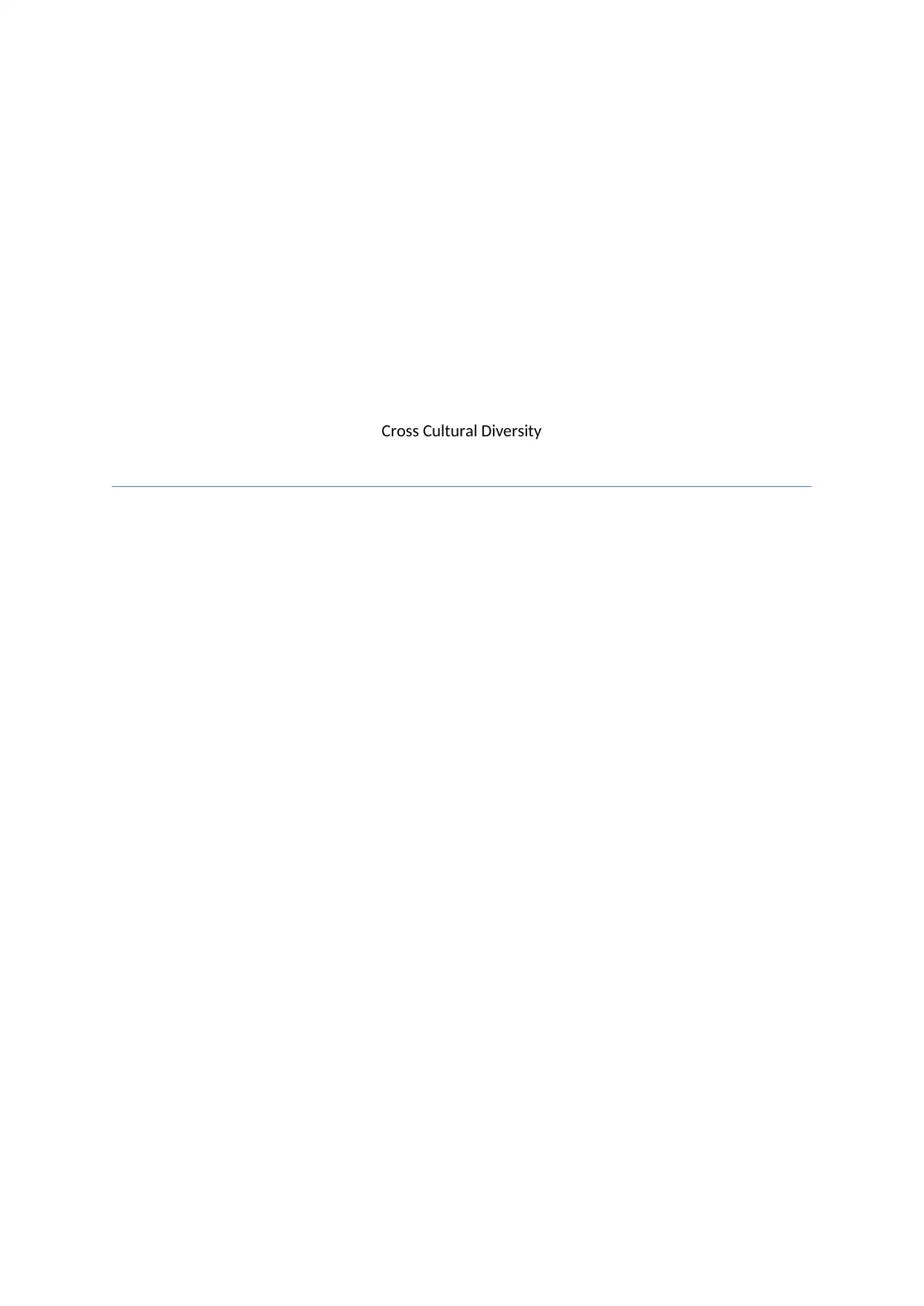
Cross Cultural Diversity
Paraphrase This Document
Need a fresh take? Get an instant paraphrase of this document with our AI Paraphraser
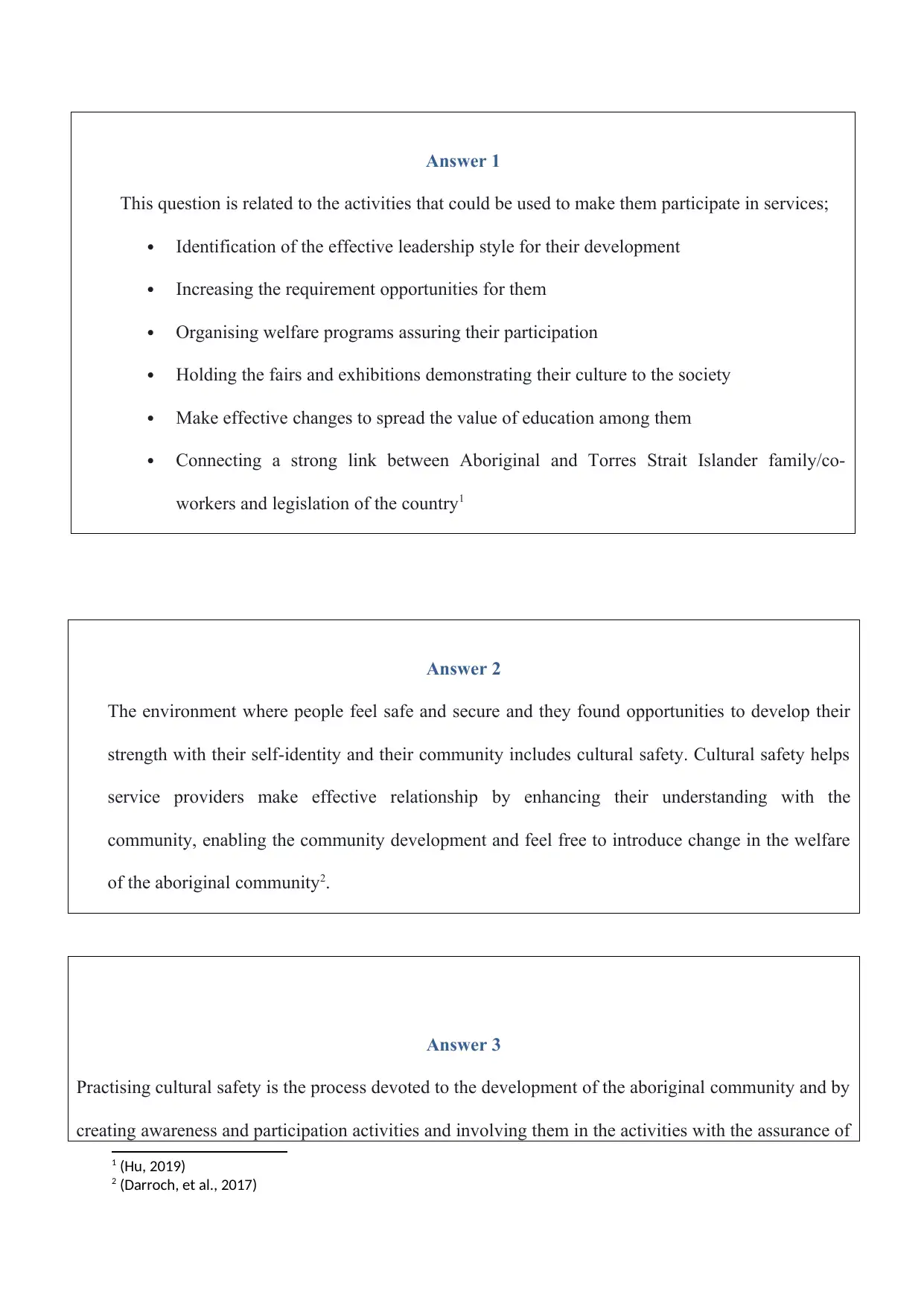
Answer 1
This question is related to the activities that could be used to make them participate in services;
Identification of the effective leadership style for their development
Increasing the requirement opportunities for them
Organising welfare programs assuring their participation
Holding the fairs and exhibitions demonstrating their culture to the society
Make effective changes to spread the value of education among them
Connecting a strong link between Aboriginal and Torres Strait Islander family/co-
workers and legislation of the country1
Answer 2
The environment where people feel safe and secure and they found opportunities to develop their
strength with their self-identity and their community includes cultural safety. Cultural safety helps
service providers make effective relationship by enhancing their understanding with the
community, enabling the community development and feel free to introduce change in the welfare
of the aboriginal community2.
Answer 3
Practising cultural safety is the process devoted to the development of the aboriginal community and by
creating awareness and participation activities and involving them in the activities with the assurance of
1 (Hu, 2019)
2 (Darroch, et al., 2017)
This question is related to the activities that could be used to make them participate in services;
Identification of the effective leadership style for their development
Increasing the requirement opportunities for them
Organising welfare programs assuring their participation
Holding the fairs and exhibitions demonstrating their culture to the society
Make effective changes to spread the value of education among them
Connecting a strong link between Aboriginal and Torres Strait Islander family/co-
workers and legislation of the country1
Answer 2
The environment where people feel safe and secure and they found opportunities to develop their
strength with their self-identity and their community includes cultural safety. Cultural safety helps
service providers make effective relationship by enhancing their understanding with the
community, enabling the community development and feel free to introduce change in the welfare
of the aboriginal community2.
Answer 3
Practising cultural safety is the process devoted to the development of the aboriginal community and by
creating awareness and participation activities and involving them in the activities with the assurance of
1 (Hu, 2019)
2 (Darroch, et al., 2017)
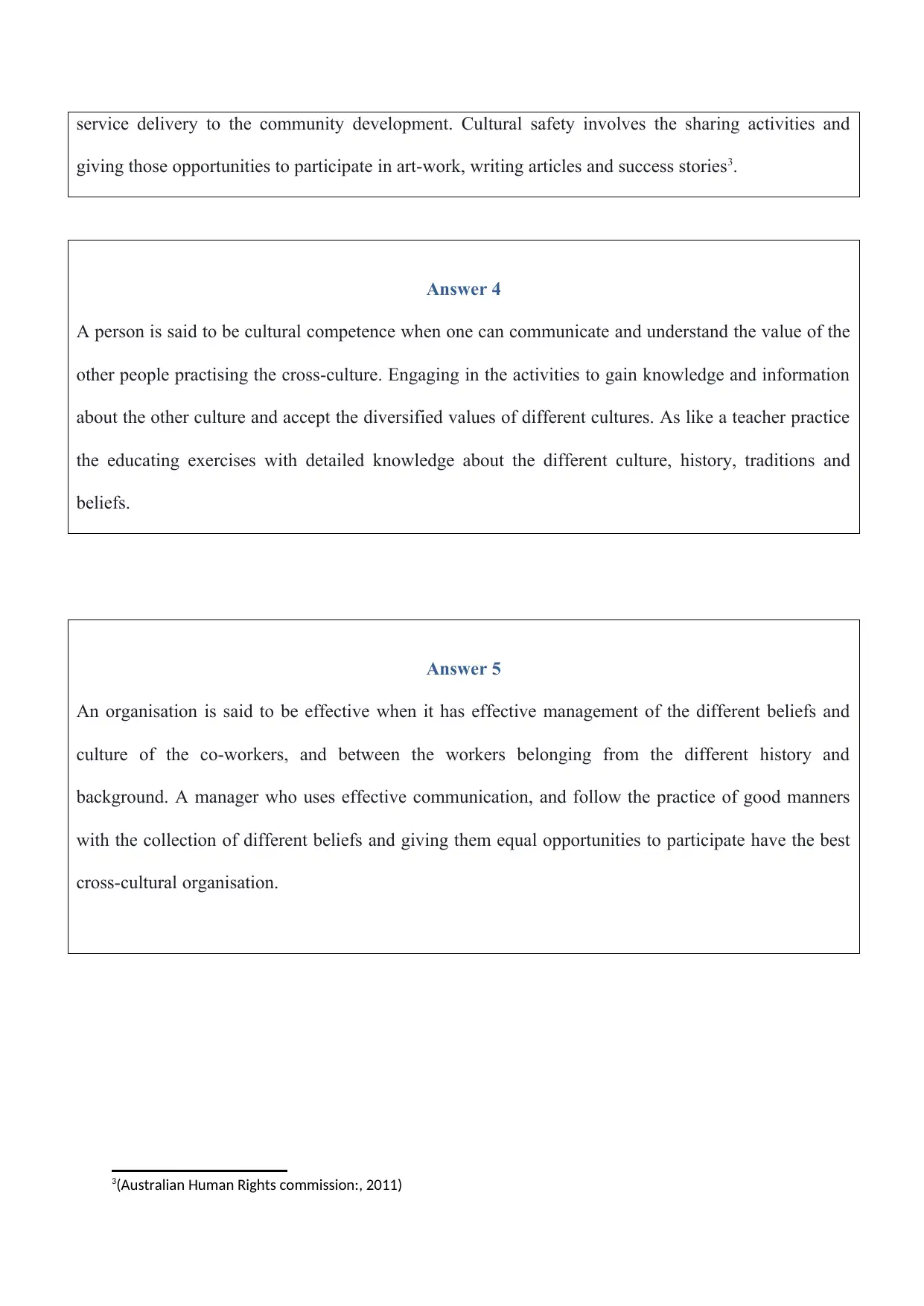
service delivery to the community development. Cultural safety involves the sharing activities and
giving those opportunities to participate in art-work, writing articles and success stories3.
Answer 4
A person is said to be cultural competence when one can communicate and understand the value of the
other people practising the cross-culture. Engaging in the activities to gain knowledge and information
about the other culture and accept the diversified values of different cultures. As like a teacher practice
the educating exercises with detailed knowledge about the different culture, history, traditions and
beliefs.
Answer 5
An organisation is said to be effective when it has effective management of the different beliefs and
culture of the co-workers, and between the workers belonging from the different history and
background. A manager who uses effective communication, and follow the practice of good manners
with the collection of different beliefs and giving them equal opportunities to participate have the best
cross-cultural organisation.
3(Australian Human Rights commission:, 2011)
giving those opportunities to participate in art-work, writing articles and success stories3.
Answer 4
A person is said to be cultural competence when one can communicate and understand the value of the
other people practising the cross-culture. Engaging in the activities to gain knowledge and information
about the other culture and accept the diversified values of different cultures. As like a teacher practice
the educating exercises with detailed knowledge about the different culture, history, traditions and
beliefs.
Answer 5
An organisation is said to be effective when it has effective management of the different beliefs and
culture of the co-workers, and between the workers belonging from the different history and
background. A manager who uses effective communication, and follow the practice of good manners
with the collection of different beliefs and giving them equal opportunities to participate have the best
cross-cultural organisation.
3(Australian Human Rights commission:, 2011)
⊘ This is a preview!⊘
Do you want full access?
Subscribe today to unlock all pages.

Trusted by 1+ million students worldwide
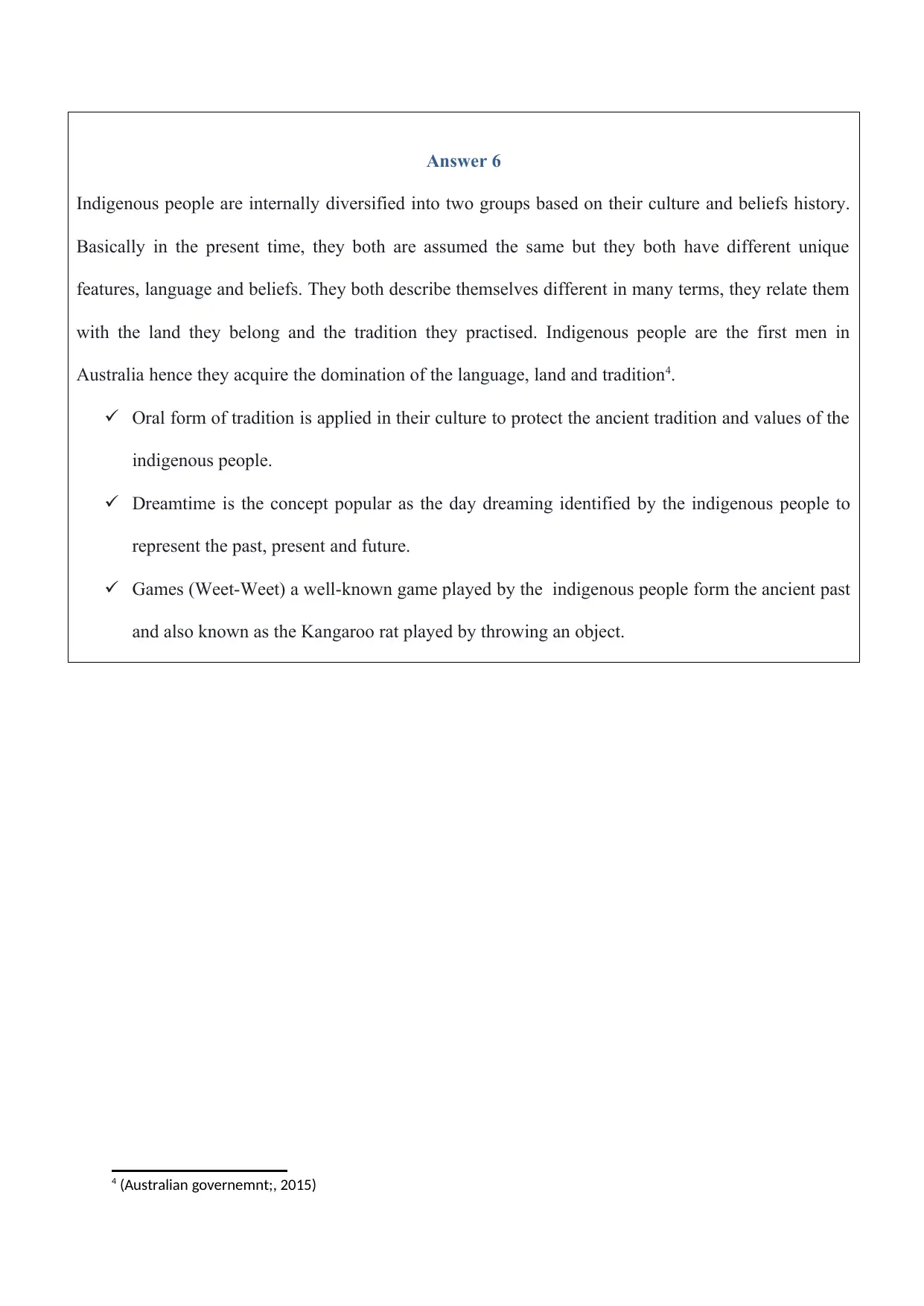
Answer 6
Indigenous people are internally diversified into two groups based on their culture and beliefs history.
Basically in the present time, they both are assumed the same but they both have different unique
features, language and beliefs. They both describe themselves different in many terms, they relate them
with the land they belong and the tradition they practised. Indigenous people are the first men in
Australia hence they acquire the domination of the language, land and tradition4.
Oral form of tradition is applied in their culture to protect the ancient tradition and values of the
indigenous people.
Dreamtime is the concept popular as the day dreaming identified by the indigenous people to
represent the past, present and future.
Games (Weet-Weet) a well-known game played by the indigenous people form the ancient past
and also known as the Kangaroo rat played by throwing an object.
4 (Australian governemnt;, 2015)
Indigenous people are internally diversified into two groups based on their culture and beliefs history.
Basically in the present time, they both are assumed the same but they both have different unique
features, language and beliefs. They both describe themselves different in many terms, they relate them
with the land they belong and the tradition they practised. Indigenous people are the first men in
Australia hence they acquire the domination of the language, land and tradition4.
Oral form of tradition is applied in their culture to protect the ancient tradition and values of the
indigenous people.
Dreamtime is the concept popular as the day dreaming identified by the indigenous people to
represent the past, present and future.
Games (Weet-Weet) a well-known game played by the indigenous people form the ancient past
and also known as the Kangaroo rat played by throwing an object.
4 (Australian governemnt;, 2015)
Paraphrase This Document
Need a fresh take? Get an instant paraphrase of this document with our AI Paraphraser
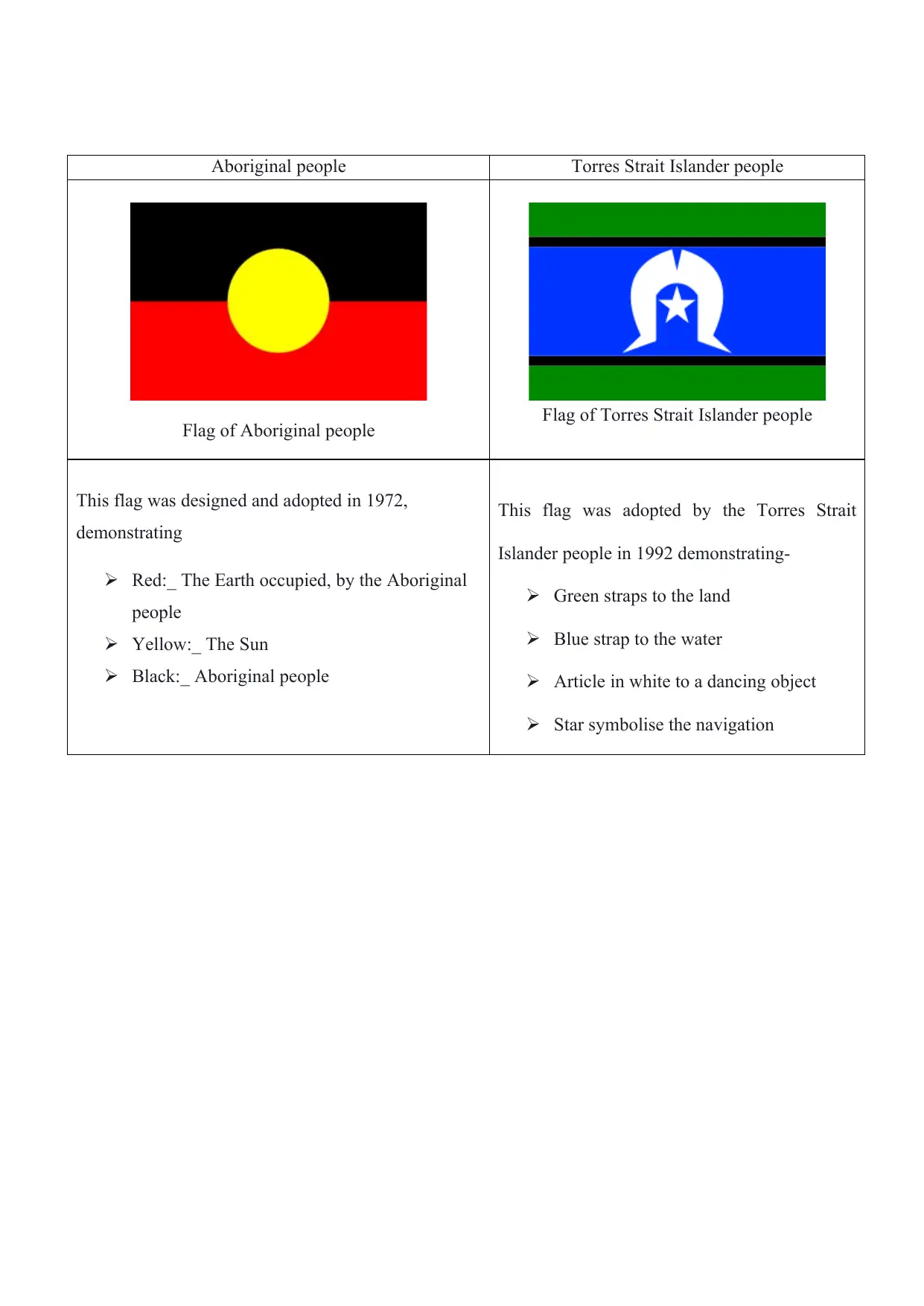
Aboriginal people Torres Strait Islander people
Flag of Aboriginal people Flag of Torres Strait Islander people
This flag was designed and adopted in 1972,
demonstrating
Red:_ The Earth occupied, by the Aboriginal
people
Yellow:_ The Sun
Black:_ Aboriginal people
This flag was adopted by the Torres Strait
Islander people in 1992 demonstrating-
Green straps to the land
Blue strap to the water
Article in white to a dancing object
Star symbolise the navigation
Flag of Aboriginal people Flag of Torres Strait Islander people
This flag was designed and adopted in 1972,
demonstrating
Red:_ The Earth occupied, by the Aboriginal
people
Yellow:_ The Sun
Black:_ Aboriginal people
This flag was adopted by the Torres Strait
Islander people in 1992 demonstrating-
Green straps to the land
Blue strap to the water
Article in white to a dancing object
Star symbolise the navigation

Answer 7
There are so many challenges faced by the Aboriginal and/or Torres Strait Islander people including the
children, women, and workers. To make better development of these following steps or strategies are
seems useful for the make the development programs with the effective coordination of the community
groups ad government organisation.
Special education and health care plan and organisation to develop the living and health of the
children.
Making social justice and legislation implementation to protect them from discrimination,
Making provision for the employment of the community.
Organising community participation program and welcoming them to the land.
Organising programs to raise awareness in the indigenous community for their rights in the
country.
There are so many challenges faced by the Aboriginal and/or Torres Strait Islander people including the
children, women, and workers. To make better development of these following steps or strategies are
seems useful for the make the development programs with the effective coordination of the community
groups ad government organisation.
Special education and health care plan and organisation to develop the living and health of the
children.
Making social justice and legislation implementation to protect them from discrimination,
Making provision for the employment of the community.
Organising community participation program and welcoming them to the land.
Organising programs to raise awareness in the indigenous community for their rights in the
country.
⊘ This is a preview!⊘
Do you want full access?
Subscribe today to unlock all pages.

Trusted by 1+ million students worldwide
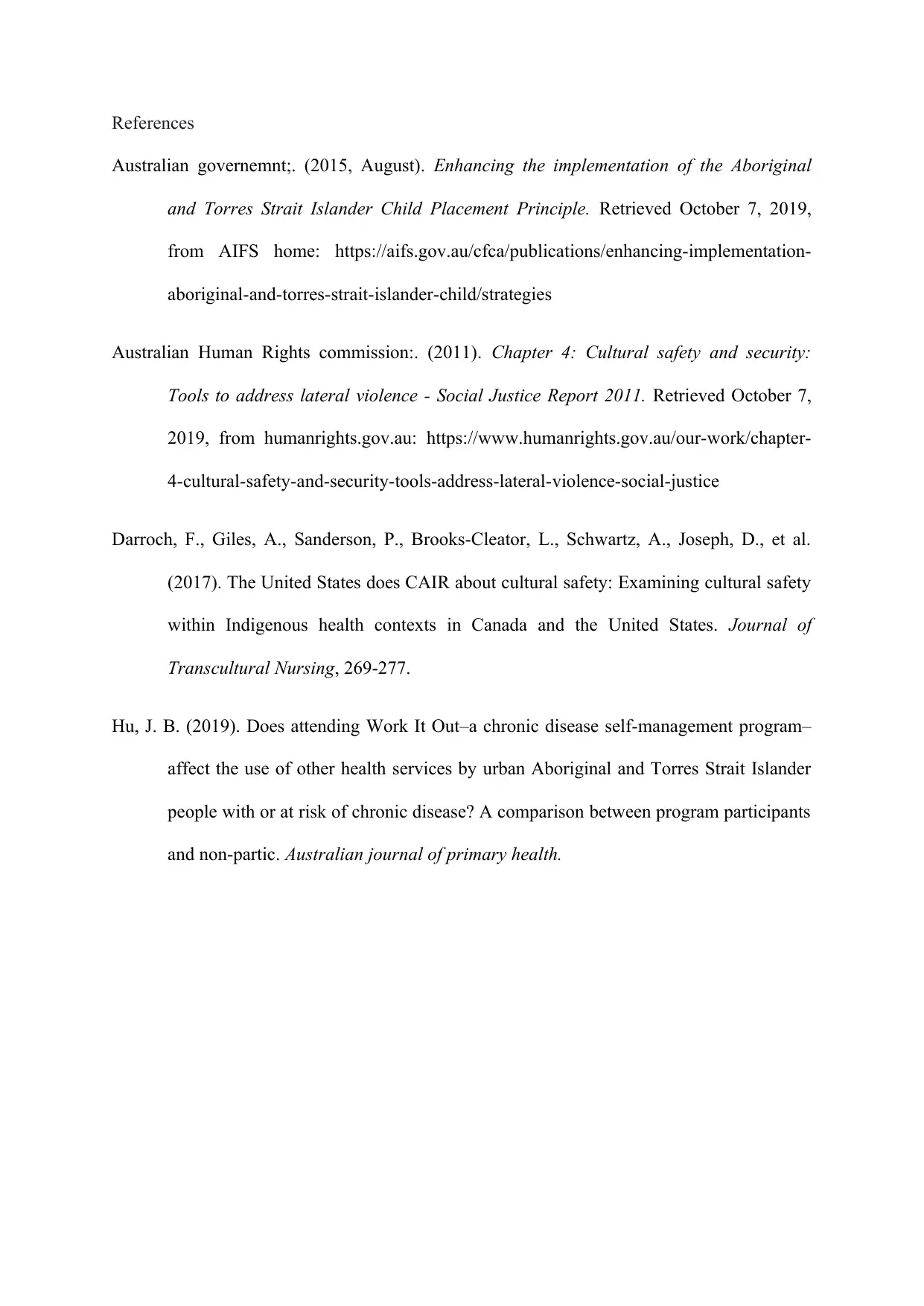
References
Australian governemnt;. (2015, August). Enhancing the implementation of the Aboriginal
and Torres Strait Islander Child Placement Principle. Retrieved October 7, 2019,
from AIFS home: https://aifs.gov.au/cfca/publications/enhancing-implementation-
aboriginal-and-torres-strait-islander-child/strategies
Australian Human Rights commission:. (2011). Chapter 4: Cultural safety and security:
Tools to address lateral violence - Social Justice Report 2011. Retrieved October 7,
2019, from humanrights.gov.au: https://www.humanrights.gov.au/our-work/chapter-
4-cultural-safety-and-security-tools-address-lateral-violence-social-justice
Darroch, F., Giles, A., Sanderson, P., Brooks-Cleator, L., Schwartz, A., Joseph, D., et al.
(2017). The United States does CAIR about cultural safety: Examining cultural safety
within Indigenous health contexts in Canada and the United States. Journal of
Transcultural Nursing, 269-277.
Hu, J. B. (2019). Does attending Work It Out–a chronic disease self-management program–
affect the use of other health services by urban Aboriginal and Torres Strait Islander
people with or at risk of chronic disease? A comparison between program participants
and non-partic. Australian journal of primary health.
Australian governemnt;. (2015, August). Enhancing the implementation of the Aboriginal
and Torres Strait Islander Child Placement Principle. Retrieved October 7, 2019,
from AIFS home: https://aifs.gov.au/cfca/publications/enhancing-implementation-
aboriginal-and-torres-strait-islander-child/strategies
Australian Human Rights commission:. (2011). Chapter 4: Cultural safety and security:
Tools to address lateral violence - Social Justice Report 2011. Retrieved October 7,
2019, from humanrights.gov.au: https://www.humanrights.gov.au/our-work/chapter-
4-cultural-safety-and-security-tools-address-lateral-violence-social-justice
Darroch, F., Giles, A., Sanderson, P., Brooks-Cleator, L., Schwartz, A., Joseph, D., et al.
(2017). The United States does CAIR about cultural safety: Examining cultural safety
within Indigenous health contexts in Canada and the United States. Journal of
Transcultural Nursing, 269-277.
Hu, J. B. (2019). Does attending Work It Out–a chronic disease self-management program–
affect the use of other health services by urban Aboriginal and Torres Strait Islander
people with or at risk of chronic disease? A comparison between program participants
and non-partic. Australian journal of primary health.
1 out of 7
Related Documents
Your All-in-One AI-Powered Toolkit for Academic Success.
+13062052269
info@desklib.com
Available 24*7 on WhatsApp / Email
![[object Object]](/_next/static/media/star-bottom.7253800d.svg)
Unlock your academic potential
Copyright © 2020–2025 A2Z Services. All Rights Reserved. Developed and managed by ZUCOL.





